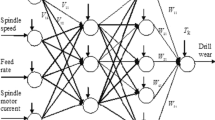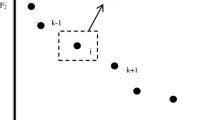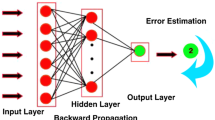Abstract
Flank wear prediction plays an important role in achieving improved productivity and better quality of the product. This study presents an effective co-evolutionary particle swarm optimization-based selective neural network ensembles (E-CPSOSEN) enabled tool wear prediction model for flank wear prediction in drilling operations. The E-CPSOSEN algorithm utilized two populations of particle swarm optimizations (PSOs) that are co-evolved simultaneously, one discrete particle swarm optimizations for evolving the binary selection vector, and the other continuous particle swarm optimizations for evolving the real weight vector. The two PSOs interact with each other through the fitness evaluation. The E-CPSOSEN algorithm is first tested on four benchmark problems taken from the literature. Upon achieving good results for test cases, the E-CPSOSEN enabled tool wear prediction model was employed to three illustrative case studies of flank wear prediction in drilling operations. Significant improvement is also obtained in comparison to the results already reported in literatures, which further reveals that the E-CPSOSEN enabled tool wear prediction model has more wonderful prediction performance than conventional single ANN-based models in predicting the flank wear in drilling operations. Moreover, an investigation was also conducted to identity the effects of the major parameters of the E-CPSOSEN algorithm upon its prediction performance. From the given results, the proposed enabled tool wear prediction model may be a promising tool for the accurate and automatic prediction of flank wear in drilling operations.





Similar content being viewed by others
References
Abu-Mahfouz, I. (2003). Drilling wear detection and classification using vibration signals and artificial neural network. International Journal of Machine Tools and Manufacture, 43(7), 707–720.
Abu-Mahfouz, I. (2005). Drill flank wear estimation using supervised vector quantization neural networks. Neural Computing and Applications, 14(3), 167–175.
Aliustaoglu, C., Ertunc, H. M., & Ocak, H. (2009). Tool wear condition monitoring using a sensor fusion model based on fuzzy inference system. Mechanical Systems and Signal Processing, 23(2), 539–546.
Breiman, L. (1996). Bagging predictors. Machine Learning, 24(2), 123–140.
Brezak, D., Majetic, D., Udiljak, T., & Kasac, J. (2012). Tool wear estimation using an analytic fuzzy classifier and support vector machines. Journal of Intelligent Manufacturing, 23(3), 797–809.
Bustillo, A., & Correa, M. (2012). Using artificial intelligence to predict surface roughness in deep drilling of steel components. Journal of Intelligent Manufacturing, 23(5), 1893–1902.
Çaydaş, U., & Ekici, S. (2012). Support vector machines models for surface roughness prediction in CNC turning of AISI 304 austenitic stainless steel. Journal of Intelligent Manufacturing, 23(3), 639–650.
Choudhury, S. K., & Raju, G. (2000). Investigation into crater wear in drilling. International Journal of Machine Tools and Manufacture, 40(6), 887–898.
Desai, C. K., & Shaikh, D. A. A. (2006). Drill wear monitoring using artificial neural network with differential evolution learning. In: IEEE International Conference on Industrial Technology (pp. 2019–2022). Mumbai, India: Renaissance Mumbai Hotel and Convention Centre.
Ertunc, H. M., & Loparo, K. A. (2001). A decesion fusion algorithm for tool wear condition monitoring in drilling. International Journal of Machine Tools and Manufacture, 41(9), 1347–1362.
Ertunc, H. M., Loparo, K. A., & Ocak, H. (2001). Tool wear condition monitoring in drilling operations using hidden Markov models (HMMs). International Journal of Machine Tools and Manufacture, 41(9), 1363–1384.
Ertunc, H. M., & Oysu, C. (2004). Drill wear monitoring using cutting force signal. Mechatronics, 14(5), 533–548.
Gajate, A., Haber, R., Toro, R., Vega, P., & Bustillo, A. (2012). Tool wear monitoring using neuro-fuzzy techniques: A comparative study in a turning process. Journal of Intelligent Manufacturing, 23(3), 869–882.
Garg, S., Pal, S. K., & Chakraborty, D. (2007). Evaluation of the performance of backpropagation and radial basis function neural networks in predicting the drill flank wear. Neural Computing and Applications, 16(4–5), 407–417.
Garg, S., Patra, K., Pal, S. K., & Chakraborty, D. (2008). Effect of different basis functions on a radial basis function network in prediction of drill flank wear from motor current signals. Soft Computing, 12(8), 777–787.
Garg, S., Patra, K., Khetrapal, V., Pal, S. K., & Chakraborty, D. (2010). Genetically evolved radial basis function network based prediction of drill flank wear. Engineering Applications of Artificial Intelligence, 23(7), 1112–1120.
Grzenda, M., Bustillo, A., & Zawistowski, P. (2012). A soft computing system using intelligent imputation strategies for roughness prediction in deep drilling. Journal of Intelligent Manufacturing, 23(5), 1733–1743.
Hansen, L. K., & Salamon, P. (1990). Neural network ensembles. IEEE Transaction on Pattern Analysis and Machine Intelligence, 12(10), 993–1001.
Hansen, J. V. (2000). Combining predictors: Meta machine learning methods and bias/variance and ambiguity decompositions. Ph.D. Dissertation of University of Aarhus, Denmark.
Hornik, K. M., Stinchcombe, M., & White, H. (1989). Multilayer feedforward networks are universal approximators. Neural Networks, 2(2), 359–366.
Huang, G., Chen, Y., & Babri, H. A. (2000). Classification ability of single hidden layer feed forward neural networks. IEEE Transaction on Neural Networks, 11(3), 799–801.
Judd, J. S. (1987). Learning in networks is hard. In: Proceedings of the First International Conference on Neural Networks (pp. 685–692). San Diego, California, New York: IEEE.
Kennedy, J., & Eberhart, R. C. (1995). Particle swarm optimization. In: Proceedings of the IEEE International Conference on Neural Networks (pp. 1942–1948), November/December 27, Perth, Australia, IV. Piscataway, NJ: IEEE Service Centre.
Kennedy, J., & Eberhart, R. C. (1997). A discrete binary version of the particle swarm optimization. In: Proceedings of the IEEE International Conference on Computational Cybernetics and Simulation (pp. 4104–4108). Piscataway, NJ: IEEE Press.
Kosmol, J., Czech, M., Klarecki, K., & Sliwka, J. (1999). The optimization of drills for machining of austenitic steel. Journal of Materials Processing Technology, 80–90(19), 117–122.
Kovac, P., Rodic, D., Pucovsky, V., Savkovic, B., & Gostimirovic, M. (2013). Application of fuzzy logic and regression analysis for modeling surface roughness in face milliing. Journal of Intelligent Manufacturing, 24(4), 755–762.
Krishnan, S. M., & Irusa, G. R. (2012). Prediction and analysis of multiple quality characteristics in drilling under minimum quantity. Proceedings of the Institution of Mechanical Engineers, Part B: Journal of Engineering Manufacture, 226(6), 1061–1070.
Krogh, A., & Vedelsby, J. (1995). Neural network ensembles cross validation, and active learning. In: Advances in neural information processing systems (Vol. 7, pp. 231–238). Denver, CO, Cambridge, MA: MIT Press.
Lee, B. Y., Liu, H. S., & Tarng, Y. S. (1998). Modelling and optimization of drilling process. Journal of Materials Processing Technology, 74(1–3), 149–157.
Li, X. L., & Tso, S. K. (1999). Drill wear monitoring based on current signals. Wear, 231(2), 172–178.
Li, P. G., & Wu, S. M. (1998). Monitoring of drill wear states by a Fuzzy pattern recognition technique. Journal of Engineering for Industry, 110(3), 352–359.
Lin, S. C., & Ting, C. J. (1995). Tool wear monitoring in drilling using force signals. International Journal of Machine Tools and Manufacture, 180(1–2), 53–60.
Lin, S. C., & Ting, C. J. (1996). Drill wear monitoring using neural network. International Journal of Machine Tools and Manufacture, 36(4), 465–475.
Lo, S.-P., & Lin, Y.-Y. (2004). Application of abductive polynomial network and grey theory to drill flank wear. Applied Artificial Intelligence: An International Journal, 18(8), 713–733.
Pal, S., Heyns, P. S., Freyer, B. H., Theron, N. J., & Pal, S. K. (2011). Tool wear monitoring and selection of optimum cutting conditions with progressive tool wear effect and input uncertainties. J ournal of Intelligent Manufacturing, 22(4), 491–504.
Panda, S. S., Chakraborty, D., & Pal, S. K. (2007). Monitoring of drill flank wear using fuzzy back-propagation neural network. The International Journal of Advanced Manufacturing Technology, 34(3–4), 227–235.
Panda, S. S., Chakraborty, D., & Pal, S. K. (2008a). Flank wear prediction in drilling using back propagation neural network and radial basis function network. Applied Soft Computing, 8(2), 858–871.
Panda, S. S., Chakraborty, D., & Pal, S. K. (2008b). Drill wear prediction using different neural network architectures. International Journal of Knowledge-based and Intelligent Engineering Systems, 12(5–6), 327–338.
Panda, S. S., Singh, A. K., Chakraborty, D., & Pal, S. K. (2006). Drill wear monitoring using back propagation neural network. Journal of Materials Processing Technology, 172(2), 283–290.
Park, K.-H., Beal, A., Kim, D., Kwon, P., & Lantrip, J. (2011). Tool wear in drilling of composite/titanium stacks using carbide and polycrystalline diamond tools. Wear, 271(11–12), 2826–2835.
Patra, K., Pal, S. K., & Bhattacharyya, K. (2007a). Artificial neural network based prediction of drill flank wear from motor current signals. Applied Soft Computing, 7(3), 929–935.
Patra, K., Pal, S. K., & Bhattacharyya, K. (2007b). Application of wavelet packet analysis in drill wear monitoring. Machining Science and Technology, 11(3), 413–432.
Patra, K., Pal, S. K., & Bhattacharyy, K. (2010). Fuzzy radial basis function (FRBF) network based tool condition monitoring system using vibration signals. Machining Science and Technology: An International Journal, 14(2), 280–300.
Quintana, G., Garcia-Romeu, M. L., & Ciurana, J. (2011). Surface roughness monitoring application based on artificial neural networks for ball-end milling operations. Journal of Intelligent Manufacturing, 22(4), 607–617.
Raghavendra, N., Koranne, R., Patra, K., & Pal, S. K. (2009). A neuro ant colony optimized model for drill flank wear prediction. International Journal for Manufacturing Science and Production, 10(3–4), 169–184.
Ridgeway, G., Madigan, D., & Richardson, T. (1999). Boosting methodology for regression problems. In: Proceedings of the 7th International Workshop on Artificial Intelligence and Statistics (pp. 152–161), Fort Lauderdale, FL, San Mateo, CA: Morgan Kaufmann.
Sanjay, C., Neema, M. L., & Chin, C. W. (2005). Modeling of tool wear in drilling by statistical analysis and artificial neural network. Journal of Materials Processing Technology, 170(3), 494–500.
Schapire, R. E. (1990). The strength of weak learnability. Machine Learning, 5(2), 197–227.
Singh, A. K., Panda, S. S., Pal, S. K., & Chakraborty, D. (2006). Predicting drill wear using an artificial neural network. The International Journal of Advanced Manufacturing Technology, 28(5–6), 456–462.
Sonar, D. K., Dixit, U. S., & Ojha, D. K. (2005). The application of a radial basis function neural network for predicting the surface roughness in a turning process. The International Journal of Advanced Manufacturing Technology, 27(7–8), 661–666.
Tsao, C. C. (2002). Prediction of flank wear of different coated drills for JIS SUS 304 stainless steel using neural network. Journal of Materials Processing Technology, 123(3), 354–360.
Wang, G. F., & Cui, Y. H. (2013). On line tool wear monitoring based on auto associative neural network. Journal of Intelligent Manufacturing, 24(6), 1085–1094.
Wang, X. Y., Wang, W., Huang, Y., Nguyen, N., & Krishnakumar, K. (2008). Design of neural network-based estimator for tool wear modeling in hard turning. Journal of Intelligent Manufacturing, 19(4), 383–396.
Weston, J. A. E., Stitson, M. O., Gammerman, A., Vovk, V., & Vapnik, V. (1996). Experiments with support vector machines. London: Technical Report: CSD-TR-96-19, Royal Holloway University of London.
Wong, Y. S., Nee, A. Y. C., Li, X. Q., & Reisdorf, C. (1997). Tool condition monitoring using laser scatter pattern. Journal of Materials Processing Technology, 63(1–3), 205–210.
Yang, W.-A., Guo, Y., & Liao, W. H. (2010). Optimization of multi-pass face milling using a fuzzy particle swarm optimization algorithm. The International Journal of Advanced Manufacturing Technology, 54(1–4), 45–57.
Yang, W.-A., Guo, Y., & Liao, W. H. (2011). Multi-objective optimization of multi-pass face milling using particle swarm intelligence. The International Journal of Advanced Manufacturing Technology, 56(5–8), 429–443.
Yang, X., Kumehara, H., & Zhang, W. (2009). Back propagation wavelet neural network based prediction of drill wear from thrust force. Computer and information Science, 2(3), 75–86.
Yildiz, A. R. (2009a). A novel hybrid immune algorithm for global optimization in design and manufacturing. Robotics and Computer-Integrated Manufacturing, 25(2), 261–270.
Yildiz, A. R. (2009b). An effective hybrid immune-hill climbing optimization approach for solving design and manufacturing optimization problems in industry. Journal of Materials Processing Technology, 50(4), 224–228.
Yildiz, A. R. (2012). A comparative study of population-based optimization algorithms for turning operations. Information Sciences, 210(25), 81–88.
Yildiz, A. R. (2013a). Optimization of cutting parameters in multi-pass turning using artificial bee colony-based approach. Information Sciences, 220(20), 399–407.
Yildiz, A. R. (2013b). A new hybrid differential evolution algorithm for the selection of optimal machining parameters in milling operations. Applied Soft Computing, 13(3), 1561–1566.
Yildiz, A. R. (2013c). Hybrid Taguchi-differential evolution algorithm for optimization of multi-pass turning operations. Applied Soft Computing, 13(3), 1433–1439.
Yildiz, A. R. (2013d). Cuckoo search algorithm for the selection of optimal machining parameters in milling operations. International Journal of Advanced Manufacturing Technology, 64(1–4), 55–61.
Zhou, Z. H., Wu, J. X., & Tang, W. (2002). Ensembling neural networks: Many could be better than all. Artificial Intelligence, 137(1–2), 239–263.
Zuperl, U., Cus, F., & Kiker, E. (2009). Adaptive network based inference system for estimation of flank wear in end-milling. Journal of Materials Processing Technology, 209(3), 1504–1511.
Acknowledgments
This work was supported by grants from the Defense Industrial Technology Development Program under Grant A2520110003 and the Program for Changjiang Scholars and Innovative Research Team in University under Grant IRT0968. The authors would like to express sincere appreciation to the anonymous referees for their detailed and helpful comments to improve the quality of this article.
Author information
Authors and Affiliations
Corresponding author
Rights and permissions
About this article
Cite this article
Yang, WA., Zhou, W., Liao, W. et al. Prediction of drill flank wear using ensemble of co-evolutionary particle swarm optimization based-selective neural network ensembles. J Intell Manuf 27, 343–361 (2016). https://doi.org/10.1007/s10845-013-0867-2
Received:
Accepted:
Published:
Issue Date:
DOI: https://doi.org/10.1007/s10845-013-0867-2




